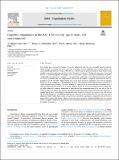Files in this item
Cognitive impairment in the U.S. : lifetime risk, age at onset, and years impaired
Item metadata
| dc.contributor.author | Hale, Jo Mhairi | |
| dc.contributor.author | Schneider, Daniel C. | |
| dc.contributor.author | Mehta, Neil K. | |
| dc.contributor.author | Myrskylä, Mikko | |
| dc.date.accessioned | 2020-04-13T10:30:02Z | |
| dc.date.available | 2020-04-13T10:30:02Z | |
| dc.date.issued | 2020-08 | |
| dc.identifier | 267091726 | |
| dc.identifier | 461caf87-dafb-45d3-bd0b-e4693c337f4d | |
| dc.identifier | 85083013763 | |
| dc.identifier | 000564549000001 | |
| dc.identifier.citation | Hale , J M , Schneider , D C , Mehta , N K & Myrskylä , M 2020 , ' Cognitive impairment in the U.S. lifetime risk, age at onset, and years impaired ' , SSM - Population Health , vol. 11 , 100577 . https://doi.org/10.1016/j.ssmph.2020.100577 | en |
| dc.identifier.issn | 2352-8273 | |
| dc.identifier.other | ORCID: /0000-0003-1343-3879/work/86538384 | |
| dc.identifier.uri | https://hdl.handle.net/10023/19789 | |
| dc.description | This study uses only secondary data analysis of the publicly available data in the Health and Retirement Study, a longitudinal project sponsored by the National Institute on Aging (NIA U01AG009740) and the Social Security Administration. | en |
| dc.description.abstract | Prior studies have analyzed the burden of cognitive impairment, but often use potentially biased prevalence-based methods or measure only years lived with impairment, without estimating other relevant metrics. We use the Health and Retirement Study (1998–2014; n = 29,304) and the preferred incidence-based Markov-chain models to assess three key measures of the burden of cognitive impairment: lifetime risk, mean age at onset, and number of years lived impaired. We analyze both mild and severe cognitive impairment (dementia) and gender, racial/ethnic, and educational variation in impairment. Our results paint a multi-dimensional picture of cognitive health, presenting the first comprehensive analysis of the burden of cognitive impairment for the U.S. population age 50 and older. Approximately two out of three Americans experience some level of cognitive impairment at an average age of approximately 70 years. For dementia, lifetime risk for women (men) is 37% (24%) and mean age at onset 83 (79) years. Women can expect to live 4.2 years with mild impairment and 3.2 with dementia, men 3.5 and 1.8 years. A critical finding is that for the most advantaged groups (i.e., White and/or higher educated), cognitive impairment is both delayed and compressed toward the very end of life. In contrast, despite the shorter lives of disadvantaged subgroups (Black and/or lower educated), they experience a younger age of onset, higher lifetime risk, and more years cognitively impaired. For example, men with at least an Associate degree have 21% lifetime dementia risk, compared to 35% among men with less than high school education. White women have 6 years of cognitively-impaired life expectancy, compared to 12 and 13 years among Black women and Latinas. These educational and racial/ethnic gradients highlight the very uneven burden of cognitive impairment. Further research is required to identify the mechanisms driving these disparities in cognitive impairment. | |
| dc.format.extent | 650129 | |
| dc.language.iso | eng | |
| dc.relation.ispartof | SSM - Population Health | en |
| dc.subject | Cognitive impairment | en |
| dc.subject | Dementia | en |
| dc.subject | Health disparities | en |
| dc.subject | Race/ethnicity | en |
| dc.subject | Education | en |
| dc.subject | RC0321 Neuroscience. Biological psychiatry. Neuropsychiatry | en |
| dc.subject | RA Public aspects of medicine | en |
| dc.subject | BF Psychology | en |
| dc.subject | H Social Sciences | en |
| dc.subject | L Education (General) | en |
| dc.subject | DAS | en |
| dc.subject | SDG 3 - Good Health and Well-being | en |
| dc.subject.lcc | RC0321 | en |
| dc.subject.lcc | RA | en |
| dc.subject.lcc | BF | en |
| dc.subject.lcc | H | en |
| dc.subject.lcc | L1 | en |
| dc.title | Cognitive impairment in the U.S. : lifetime risk, age at onset, and years impaired | en |
| dc.type | Journal article | en |
| dc.contributor.institution | University of St Andrews. School of Geography & Sustainable Development | en |
| dc.identifier.doi | 10.1016/j.ssmph.2020.100577 | |
| dc.description.status | Peer reviewed | en |
This item appears in the following Collection(s)
Items in the St Andrews Research Repository are protected by copyright, with all rights reserved, unless otherwise indicated.

